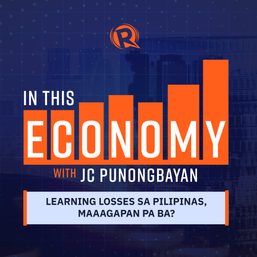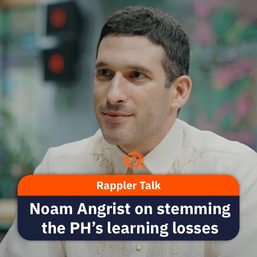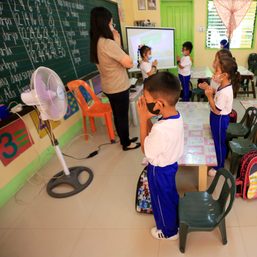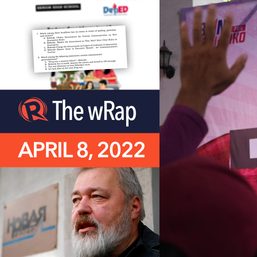SUMMARY
This is AI generated summarization, which may have errors. For context, always refer to the full article.
![[ANALYSIS] Why we need to safely reopen PH schools as soon as possible](https://www.rappler.com/tachyon/2020/12/pandemic-education-crisis-december-18-2020.jpg)
Philippine education was in a very bad place before the pandemic — more so now.
Last year we learned the dismal results of the 2018 Program for International Student Assessment (PISA), which the Philippines joined for the first time ever.
Rather embarrassingly, among the 79 participating countries, we ranked dead last in reading and second to last in math and science. (READ: Dismal PISA rankings: A wake-up call for Filipinos)
This year, two more education studies confirm how far we’ve been left behind. And, as if to rub salt on our wounds, the pandemic is another great setback to our already gloomy education scene.
How can we get out of this morass? There are no quick fixes to our education crisis. But in the short run, we need to reopen schools as soon and as safely as possible.
New studies, unsurprising results
On Tuesday, December 8, the results of the 2019 Trends in International Mathematics and Science Study 2019 (TIMSS) were published.
Unsettlingly, but unsurprisingly, the Philippines also ranked dead last among all participating countries based on Grade 4 tests on math and science.
In fact, footnotes indicated that so many Filipino students got extremely low scores, enough to compromise the very reliability of the estimates.
Figures 1 and 2 show that the results were bad not just across countries (neighboring Singapore consistently topped the rankings, followed by other Asian economies like Hong Kong, South Korea, Taiwan, and Japan) but also across time (from 2003, the last time we joined TIMSS, our math score plunged by 17%, and our science score by 25%).
Figure 1.
Figure 2.
Interestingly, Filipino girls significantly outperformed boys (Figure 3). Among the participating countries, our gender gap turns out to be the largest in math and the 6th largest in science. Still, steep performance drops were seen in both sexes.
Figure 3.
A bit earlier, the results of the first-ever Southeast Asia Primary Learning Metrics (SEA-PLM) were also published. This study aimed to establish benchmark figures on the reading, writing, and math performance of select ASEAN countries, including the Philippines.
Sure, we’re not dead last this time. But our scores were still upsetting, especially vis-à-vis Vietnam and Malaysia (Figure 4).
A mere 10% of Filipino Grade 5 students met the minimum reading performance they ought to achieve at the end of primary school. This proportion pales in comparison with Vietnam’s 82% and Malaysia’s 58%.
Meanwhile, an even lower 5% of Filipino students attained good writing skills, versus 52% of Vietnamese students and 31% of Malaysian students.
Finally, just 17% of Filipino students attained minimum math competencies, in contrast with 92% of Vietnamese students and 64% of Malaysian students.
Figure 4.
All 3 assessments — PISA, TIMSS, and SEA-PLM — point to the same lamentable conclusion: Philippine education sucks at reading, writing, math, and science.
Arguably the most worrisome of all is reading: if Filipino students can’t read well, how are they supposed to learn in most other subjects?
Worsened by the pandemic
The above studies offer a snapshot of Philippine education before COVID-19. Imagine how much worse things are now.
Because of the Duterte government’s botched pandemic response, policymakers have had no choice but to shut down face-to-face classes this school year.
Originally slated on August 24, classes in public schools were instead moved to October 5 due to the bottomless well of problems posed by distance learning — including the writing, printing, and distribution of modules; the production of television and radio programs to aid students; and the provision of gadgets and internet access to students nationwide.
There are several reasons to believe young Filipinos aren’t getting the education they need and deserve.
Teachers are hard put to ensure their lessons are getting across to their students online. Lots of students have lousy internet connection, and online classes are also a poor substitute to classroom interactions. Not all parents have enough patience or competence to teach their own children, and distractions abound at home.
As far as I know, there’s no study yet on the potential impact of remote learning on our students’ future test scores.
In the US, a 2015 study by Stanford University on 158 online charter schools found that “the majority of online charter students had far weaker academic growth in both math and reading compared to their traditional public school peers.” In a typical school year, that translates to 180 lost days of learning math and 72 lost days of learning reading.
A more recent analysis by McKinsey and Company showed that, amid the pandemic, American students could suffer 3 to 4 months of lost learning if they receive but average-quality distance learning, 7 to 11 months with poor distance learning, and 12 to 14 months with no distance learning whatsoever. The losses are likely larger for poor, black, and Hispanic students.
In the Philippines, expect similar learning losses for students across the board. But the losses might be smaller for richer students in possession of all the gadgets they need plus 24/7 internet connectivity. Consequently, existing inequalities in education access could worsen.
We haven’t even talked about the students who chose to drop out of school altogether.
Costs, benefits of reopening
To mitigate the ill effects of remote learning, we need to bring students back into classrooms as soon and as safely as possible. The Philippines, in fact, is one of the few countries in Asia that haven’t yet reopened schools.
A recent Asian Development Bank study showed that the full resumption of face-to-face classes in the Philippines could bump up COVID-19 deaths by 8%.
But the total costs of school closures — including forgone future productivity due to lost time in school, parents’ income losses, and private teachers’ income losses — could be a whopping 70 times larger than the monetized benefits of preventing deaths.
In other words, closing schools seems to be a poor way of saving people’s health and lives.
Moreover, school closures could push young people to smoke or drink more, among other risky behaviors. This could further lessen the health benefits of school closures.
The Duterte government is toying with the idea of bringing back face-to-face classes next year, especially in low-risk areas. More than a thousand schools will conduct pilot tests by January.
But so many schools have been converted into quarantine facilities, and many still lack enough handwashing facilities, clinics, and nurses — not to mention large-enough classrooms to ensure social distancing.
Before we can scale up the reopening of schools, the pilot studies also need to be conducted with scientific rigor. Otherwise, we will put children needlessly at risk.
Thankfully, as indicated by the ADB study, the risks of reopening schools can mitigated by, say, targeting movement restrictions on older students, reducing classroom rotations and breaks, and reopening schools in areas with little to no local transmission of COVID-19.
At the end of the day, reopening schools will always be fraught with risks and costs. But failing to do so will only deepen our country’s already dire education crisis. – Rappler.com
JC Punongbayan is a PhD candidate and teaching fellow at the UP School of Economics. His views are independent of the views of his affiliations. Follow JC on Twitter (@jcpunongbayan) and Usapang Econ (usapangecon.com).
Add a comment
How does this make you feel?


![[Time Trowel] Evolution and the sneakiness of COVID](https://www.rappler.com/tachyon/2024/02/tl-evolution-covid.jpg?resize=257%2C257&crop=455px%2C0px%2C1080px%2C1080px)




![[EDITORIAL] Ano sana ang takeaway ni Sara Duterte sa firesale ng mga laptops?](https://www.rappler.com/tachyon/2023/05/animated-DEPED-laptop-fiasco-carousel.jpg?resize=257%2C257&crop_strategy=attention)


There are no comments yet. Add your comment to start the conversation.